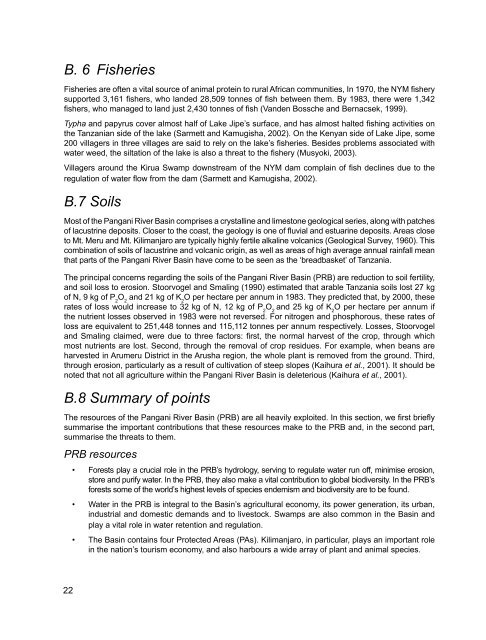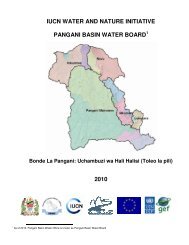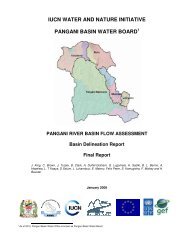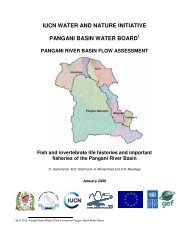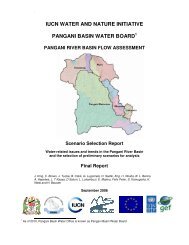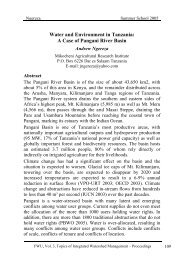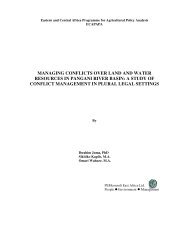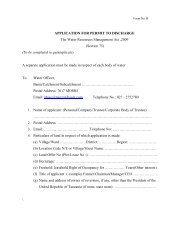PANGANI BASIN WATER BOARD
PANGANI BASIN WATER BOARD
PANGANI BASIN WATER BOARD
Create successful ePaper yourself
Turn your PDF publications into a flip-book with our unique Google optimized e-Paper software.
B. 6 Fisheries<br />
Fisheries are often a vital source of animal protein to rural African communities, In 1970, the NYM fishery<br />
supported 3,161 fishers, who landed 28,509 tonnes of fish between them. By 1983, there were 1,342<br />
fishers, who managed to land just 2,430 tonnes of fish (Vanden Bossche and Bernacsek, 1999).<br />
Typha and papyrus cover almost half of Lake Jipe’s surface, and has almost halted fishing activities on<br />
the Tanzanian side of the lake (Sarmett and Kamugisha, 2002). On the Kenyan side of Lake Jipe, some<br />
200 villagers in three villages are said to rely on the lake’s fisheries. Besides problems associated with<br />
water weed, the siltation of the lake is also a threat to the fishery (Musyoki, 2003).<br />
Villagers around the Kirua Swamp downstream of the NYM dam complain of fish declines due to the<br />
regulation of water flow from the dam (Sarmett and Kamugisha, 2002).<br />
B.7 Soils<br />
Most of the Pangani River Basin comprises a crystalline and limestone geological series, along with patches<br />
of lacustrine deposits. Closer to the coast, the geology is one of fluvial and estuarine deposits. Areas close<br />
to Mt. Meru and Mt. Kilimanjaro are typically highly fertile alkaline volcanics (Geological Survey, 1960). This<br />
combination of soils of lacustrine and volcanic origin, as well as areas of high average annual rainfall mean<br />
that parts of the Pangani River Basin have come to be seen as the ‘breadbasket’ of Tanzania.<br />
The principal concerns regarding the soils of the Pangani River Basin (PRB) are reduction to soil fertility,<br />
and soil loss to erosion. Stoorvogel and Smaling (1990) estimated that arable Tanzania soils lost 27 kg<br />
of N, 9 kg of P 2<br />
O 2<br />
and 21 kg of K 2<br />
O per hectare per annum in 1983. They predicted that, by 2000, these<br />
rates of loss would increase to 32 kg of N, 12 kg of P 2<br />
O 2<br />
and 25 kg of K 2<br />
O per hectare per annum if<br />
the nutrient losses observed in 1983 were not reversed. For nitrogen and phosphorous, these rates of<br />
loss are equivalent to 251,448 tonnes and 115,112 tonnes per annum respectively. Losses, Stoorvogel<br />
and Smaling claimed, were due to three factors: first, the normal harvest of the crop, through which<br />
most nutrients are lost. Second, through the removal of crop residues. For example, when beans are<br />
harvested in Arumeru District in the Arusha region, the whole plant is removed from the ground. Third,<br />
through erosion, particularly as a result of cultivation of steep slopes (Kaihura et al., 2001). It should be<br />
noted that not all agriculture within the Pangani River Basin is deleterious (Kaihura et al., 2001).<br />
B.8 Summary of points<br />
The resources of the Pangani River Basin (PRB) are all heavily exploited. In this section, we first briefly<br />
summarise the important contributions that these resources make to the PRB and, in the second part,<br />
summarise the threats to them.<br />
PRB resources<br />
• Forests play a crucial role in the PRB’s hydrology, serving to regulate water run off, minimise erosion,<br />
store and purify water. In the PRB, they also make a vital contribution to global biodiversity. In the PRB’s<br />
forests some of the world’s highest levels of species endemism and biodiversity are to be found.<br />
• Water in the PRB is integral to the Basin’s agricultural economy, its power generation, its urban,<br />
industrial and domestic demands and to livestock. Swamps are also common in the Basin and<br />
play a vital role in water retention and regulation.<br />
• The Basin contains four Protected Areas (PAs). Kilimanjaro, in particular, plays an important role<br />
in the nation’s tourism economy, and also harbours a wide array of plant and animal species.<br />
22


